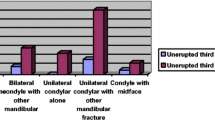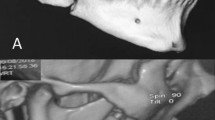Abstract
Purpose
The aim of this study was to assess the influence of position of mandibular 3rd molar on angle and condylar fractures.
Materials and Methods
Panoramic radiographs were used to determine the mandibular fracture patterns based on the presence or absence of the third molar.
Results
Of the 64 patients with mandibular fractures, condyle and angle fractures were found to be 67 and 33 % respectively. The greatest percentage (75 %) of condylar fractures were associated with erupted third molar teeth, and 25 % had impacted teeth. Subcondylar region was found to be the most common site that predisposes to fracture. Moderate force lead to condylar fracture when third molar is erupted or absent and mild force showed angle fracture when third molar is impacted. Increased incidence of angle fracture was observed when tooth is in mesioangular and distoangular position.
Conclusion
Impacted mandibular 3rd molar leads to an increased risk of angle fracture and decreased risk of condylar fracture especially when they are more deeply seated.




Similar content being viewed by others
References
Meisami T, Sojat A, Sandor GKB, Lawrence HP, Clokie CML (2002) Impacted third molars and risk of angle fracture. Int J Oral Maxillofac Surg 31(2):140–144
Lee JT, Dodson TB (2000) The effect of mandibular third molar presence and position on the risk of an angle fracture. J Oral Maxillofac Surg 58(4):394–398
Weiss L (1965) Static loading of the mandible. Oral Surg Oral Med Oral Pathol 19:253
Safdar N, Meechan J (1995) Relationship between fractures of the mandibular angle and the presence and state of eruption of the lower third molar. Oral Surg Oral Med Oral Pathol Oral Radiol Endod 79(6):680–684
Maaita J, Alwrikat A (2000) Is the mandibular third molar a risk factor for mandibular angle fracture? Oral Surg Oral Med Oral Pathol Oral Radiol Endod 89(2):143
Ugboko VI, Oginni FO, Owotade FJ (2000) An investigation into the relationship between mandibular third molars and angle fractures in Nigerians. Br J Oral Surg 38:427–429
Zhu SJ, Choi BH, Kim HJ, Park WS, Huh JY, Jung JH, Kim BY, Lee SH (2005) Relationship between the presence of unerupted mandibular third molars and fractures of the mandibular condyle. Int J Oral Maxillofac Surg 34(4):382–385
Duan DH, Zhang Y (2008) Does the presence of mandibular third molars increase the risk of angle fracture and simultaneously decrease the risk of condylar fracture? Int J Oral Maxillofac Surg 37(1):25–28
Winter GB (1926) Impacted third molars. American Medical Book Co., St. Louis, pp 241–279
Pell G, Gregory G (1993) Impacted mandibular third molars: classification and modified technique for removal. Dental Dig 39:330–338
Archer W (1975) Oral and maxillofacial surgery, vol 1, 5th edn. Saunders, Philadelphia, 311:259–260
Kelly D, Harrigan W (1975) A survey of facial fractures related to teeth and edentulous regions. J Oral Surg 33:146–149
Fuselier JC, Ellis EE III, Dodson TB (2002) Do mandibular third molars alter the risk of angle fracture? J Oral Maxillofac Surg 60(5):514–518
Vivek GK (2014) The role of mandibular 3rd molars on the incidence of condylar fractures—a clinical study. IOSR J Dental Med Sci 13(5):27–30
Krimmel M, Reinert S (2000) Mandibular fracture after third molar removal. J Oral Maxillofac Surg 58:1110–1112
Reitzik M, Lownie JF, Cleaton JP, Austin J (1978) Experimental fractures of the monkey mandibles. Int J Oral Surg 7(2):100–103
Wolujewicz MA (1980) Fractures of the mandible involving the impacted third molar tooth: an analysis of 47 cases. Br J Oral Surg 18(2):125–131
Rajasekhar G, Sudhir R, Nandagopal V, Rajeev Reddy K, Vinay Kumar G (2014) Impacted mandibular third molars and their influence on mandibular angle and condyle fractures—a retrospective study. J Craniomaxillofac Surg 42(7):1102–1105
Rajkumar K, Sinha Ramen, Chowdhury Roy, Chattopadhyay PK (2009) Mandibular third molars as a risk factor for angle fractures: a retrospective study. J Maxillofac Oral Surg 8(3):237–240
Halmos D, Ellis E III, Dodson T (2004) Mandibular third molars and angle fractures. J Oral Maxillofac Surg 62(9):1076–1081
Kober C, Sader R, Thiele H, Bauer HJ, Zeilhofer HF, Hoffmann KH, Horch HH (2001) Stress analysis of the human mandible in standard trauma situations with numerical simulation. Mund Kiefer Gesichtschir 5:114–119
Huelke and Burdi (1964) Location of mandibular fractures related to teeth and edentulous regions. J Oral Surg 22:396–405
Schwimmer A, Stern R, Kritchman D (1983) Impacted third molars: a contributing factor in mandibular fractures in contact sports. Am J Sports Med 11:262
Author information
Authors and Affiliations
Corresponding author
Rights and permissions
About this article
Cite this article
Revanth Kumar, S., Sinha, R., Uppada, U.K. et al. Mandibular Third Molar Position Influencing the Condylar and Angular Fracture Patterns. J. Maxillofac. Oral Surg. 14, 956–961 (2015). https://doi.org/10.1007/s12663-015-0777-2
Received:
Accepted:
Published:
Issue Date:
DOI: https://doi.org/10.1007/s12663-015-0777-2




